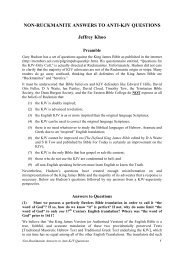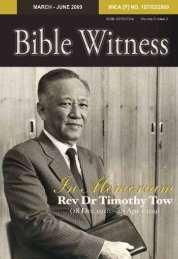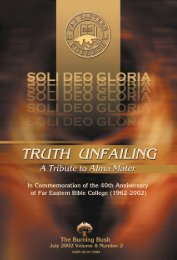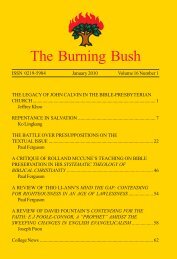Pioneering in - Far Eastern Bible College
Pioneering in - Far Eastern Bible College
Pioneering in - Far Eastern Bible College
Create successful ePaper yourself
Turn your PDF publications into a flip-book with our unique Google optimized e-Paper software.
fertilisation. Another round of clear<strong>in</strong>g prepares the ratherundulat<strong>in</strong>g ground for cultivation.In the South Seas, there are only two seasons, a wet and a dry.This obliges them to plant only once a year, and this work beg<strong>in</strong>stwo months before the ra<strong>in</strong>s. After the plant<strong>in</strong>g is completed theybuild thatched shelters among the paddy to live <strong>in</strong> for theconvenience of look<strong>in</strong>g after the crop.The Dyaks have two big festivals <strong>in</strong> the year. They are:sow<strong>in</strong>g and reap<strong>in</strong>g. Although they keep cattle, these are not usedfor plant<strong>in</strong>g paddy on the hill-slopes. They are used for fooddur<strong>in</strong>g the celebrations.Plant<strong>in</strong>g solely by human labour has nurtured a cooperativespirit. By turns they help one another <strong>in</strong> plant<strong>in</strong>g and reap<strong>in</strong>g. Forexample, today is my turn to plant. The whole village will come tomy help. If it is your turn tomorrow to plant, the whole villagewould also go to your help, and so on, till all the plant<strong>in</strong>g is done.In this cooperative enterprise they not only do not get paid butalso provide their own food for the work<strong>in</strong>g expedition. In otherwords, each man eats his own rice while help<strong>in</strong>g out hisneighbour.Speak<strong>in</strong>g about the Dyak’s place of abode, I often declarethem to amphibious. Amphibious not <strong>in</strong> the sense that they live onland and water but <strong>in</strong> the sense that they live corporately andseverally. They have villages. But, no matter how few theirnumbers, each village is built on one house which we called“longhouse” and they “lam<strong>in</strong>”. If their chiefta<strong>in</strong> has picked a spotfor the village by putt<strong>in</strong>g up his house, the people would one byone build their homes adjo<strong>in</strong><strong>in</strong>g one another’s. Although a wholevillage might embrace a population of one or two thousand, thehouse would still be one. Thus, you can measure the numbers <strong>in</strong> avillage by the length of their house. The longer the house, themore populous the village. The longhouse is not entirely for92
















